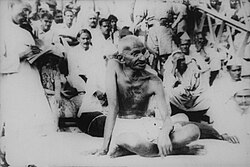1934 Nepal–India earthquake
IST | |
| Magnitude | 8.0 Mw[1] |
|---|---|
| Depth | 15 km (9.3 mi)[1] |
| Epicenter | 26°52′N 86°35′E / 26.86°N 86.59°E[1] |
| Fault | Main Frontal-Himalayan Thrust |
| Max. intensity | MMI X (Extreme)[2] |
| Casualties | 10,700–12,000 |
The 1934 Nepal–India earthquake or 1934 Bihar–Nepal earthquake was one of the worst
Earthquake
The epicentre for this event was located in eastern Nepal about 9.5 km (5.9 mi) south of
Ground effects
A particular phenomenon of the earthquake was that sand and water vents appeared throughout the central vents of the earthquake area. The ground around these sand fissures subsided, causing more damage.[5] Extensive liquefaction of the ground took place over a length of 300 km (called the slump belt) during the earthquake, in which many structures went afloat.[6]

In Muzaffarpur, sand fissures erupted at several places in town. The wells were choked with sand, while water levels in tanks became shallower due to sand deposited in the tank beds. Most of the buildings in Muzzafarpur were damaged. All the kutcha (ramshackle) buildings collapsed, while other pukka (solidly built) buildings suffered damage due to sinking and cracking of the ground.[5]
Damage
The three major towns of the
In
The number of deaths was 10,700–12,000[4][2] with 7,253 recorded in Bihar.[7]
A 1935 work by Major General Brahma Shamsher documenting the event, Nepalko Maha Bhukampa 1990, stated that this was Nepal's most destructive earthquake in living memory, and praised the
Aftermath
See also
- 1833 Bihar–Nepal earthquake
- 1988 Nepal earthquake
- April 2015 Nepal earthquake
- May 2015 Nepal earthquake
- List of earthquakes in 1934
- List of earthquakes in India
References
- ^ a b c ISC (2015), ISC-GEM Global Instrumental Earthquake Catalogue (1900–2009), Version 2.0, International Seismological Centre
- ^ a b U.S. Geological Survey. "Historic Earthquakes – Bihar, India – Nepal". U.S. Department of the Interior. Archived from the original on 29 April 2015. Retrieved 29 April 2015.
- ^ "Significant earthquake". National Geophysical Data Center. Archived from the original on 16 December 2017. Retrieved 16 February 2012.
- ^ ISBN 978-0-313-08747-9.
- ^ a b c d Nasu, Nobuji (20 March 1935). "The Great Indian Earthquake of 1934" (PDF). Earthquake Research Institute. Archived from the original (PDF) on 6 May 2015. Retrieved 30 April 2015.
- ^ Murty, C.V.R.; Malik, Javed N. "Challenges of Low-to-Moderate Seismicity in India" (PDF). Archived from the original (PDF) on 10 June 2012. Retrieved 30 April 2015.
- ^ a b c Brett, William Bailie (1935). A Report on the Bihar Earthquake and on the Measures Taken in Consequence Thereof Up to the 31st December 1934. Superintendent, Government Print. Available at The South Asia Archive
- ISBN 978-0-521-58900-0.
- ^ a b Bipin Adhikari. The Great Earthquake of 1934 Archived 29 May 2015 at the Wayback Machine. NewSpotLight Nepal News Magazine, Vol. 8, No. 22, 22 May 2015. Accessed 29 May 2015.
- ISBN 9789937330152
- ISBN 978-0-415-36096-8.
- ^ "When Tagore accused Gandhi of superstition". 28 March 2020.
- ^ "Suggesting religious reasons for quakes isn't new: Mahatma Gandhi did that in 1934". 30 April 2015.
- ^ Ramaswami Venkataraman; India. Ministry of Information and Broadcasting. Publications Division (1990). So may India be great: selected speeches and writings of President R. Venkataraman. Publication Division, Ministry of Information and Broadcasting, Govt. of India.
- ISBN 9788187614050.
- ^ "Freedom Fighter Dr Maghfoor Ahmad Ajazi remembered on Republic Day". Prabhat Khabar (in Hindi). 24 January 2022.
- ^ "मग़फ़ुर अहमद अजाज़ी : जंग ए आज़ादी का गुमनाम सिपाही!". Teesri Jung (in Hindi). 4 March 2021.
Further reading
- Singh, D. D.; Gupta, H. K. (1979), "Source dynamics of two great earthquakes of the Indian subcontinent: The Bihar-Nepal earthquake of January 15, 1934, and the Quetta earthquake of May 30, 1935", Bulletin of the Seismological Society of America, 70 (3),
- Marcussen, Eleonor (January 2022). Acts of Aid: Politics of Relief and Reconstruction in the 1934 Bihar–Nepal Earthquake. Cambridge: Cambridge University Press. ISBN 978-1-108-83809-2.
- Riesner, M.; Bollinger, L.; Rizza, M.; Klinger, Y.; Karakaş, Ç.; Sapkota, S. N.; Shah, C.; Guérin, C.; Tapponnier, P. (2023). "Surface rupture and landscape response in the middle of the great Mw 8.3 1934 earthquake mesoseismal area: Khutti Khola site". Scientific Reports. 13 (1): 4566. PMID 36941305.
External links
- 1934 Mw 8.1 Bihar/Nepal earthquake 15 January 1934 – Cooperative Institute for Research in Environmental Sciences
- Intensity Map (Archived) – Amateur Seismic Centre
- The International Seismological Centre has a bibliography and/or authoritative data for this event.
